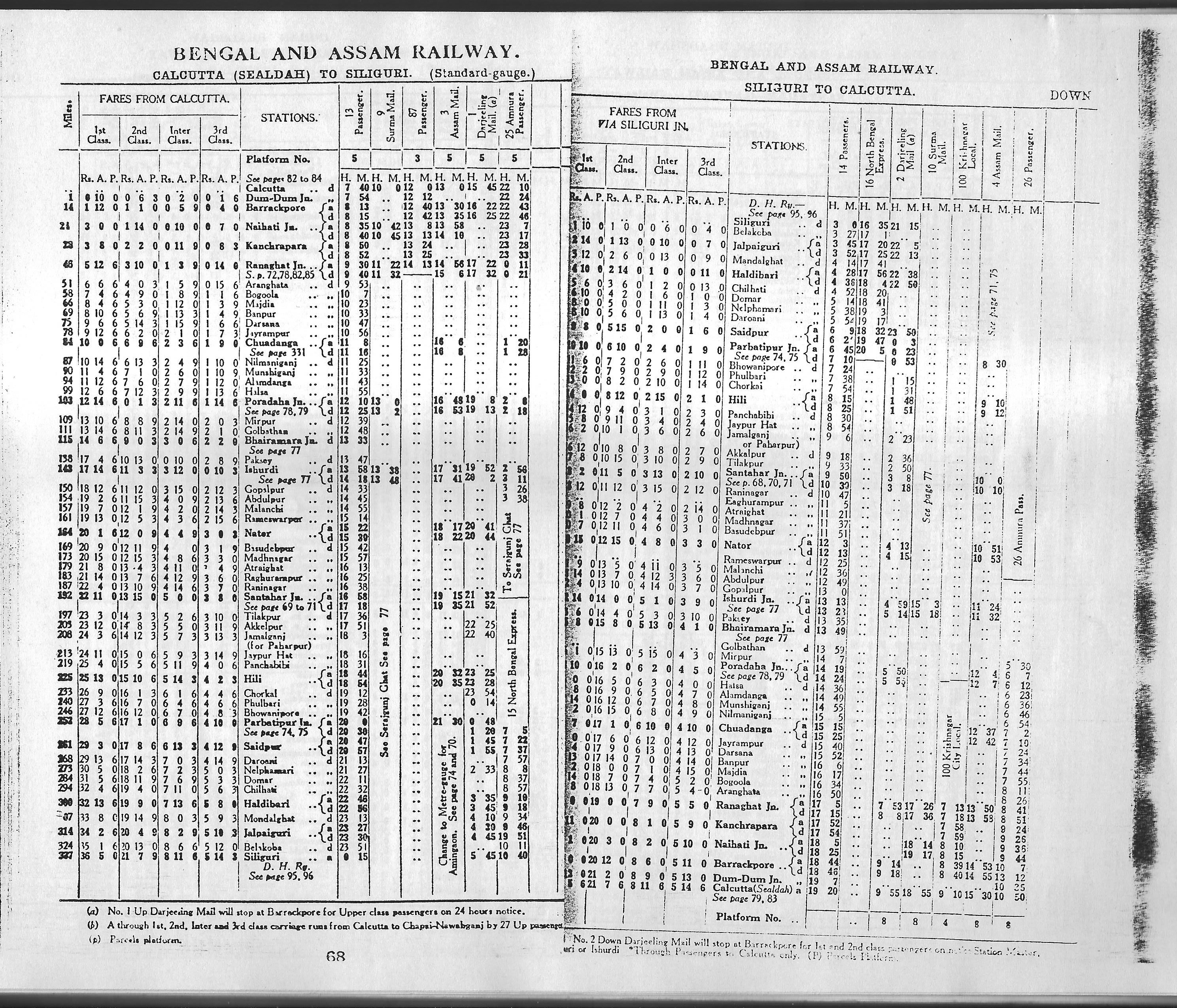This is from a much-copied Bradshaw from June 1944. However, by then the Eastern Bengal Railway and Assam Bengal Railway had been merged in a short-lived marriage resulting in the Bengal & Assam Railway in order to facilitate the war effort against Japan. The US armed forces had then taken over most of the train traffic going into Assam. For once, the British took a back seat in India.
It would be instructive to compare these timings with those of the pre-war period (say 1939) as wartime shortages and military traffic may have reduced speeds considerably. Wartime exigencies caused a number of branch lines in different parts of India to close by 1940, some never to reopen.
The timings of the up and down Mail:

Note that the full details of stations and trains between Sealdah and Ranaghat are not given above. They are given below:


Here is a departure board from Sealdah from around the same time. The Darjeeling Mail’s departure time is not clear, but probably close to the 15.45 given in the timetable.

Coming back to the main timetable above, the future border stations of Gede/Darsana and Chilhati/Haldibari can be seen. Not exactly, as Gede station was built after Partition. The last station on the Indian side in this timetable would be Banpur. On the Pakistani side, the existing Darsana station was felt to be too close to the enemy border so a new Darsana station was built a little further east, which lay on the new main line from Khulna to the north. Similarly New Gitaldaha was built somewhat further from the earlier Gitaldaha which was close to the border.
The old network of the EBR was so Calcutta-centric that important towns in the western half of East Pakistan had never been connected before. Even for that a new line had to be constructed between Jessore and new Darsana, somewhat like the far more complicated Assam Rail Link which India built in 1948-50.
The Hardinge Bridge is near Paksey station.
Also note the station of Hili which lies exactly on the border. The Radcliffe Commission stated that in that area the border was defined as the railway line is. Even till the 2000s it was considered the easiest place to come and go between India and Bangladesh.
At the northern end, the terminus of Siliguri later became the unimportant station of Siliguri Town, between the newly built major stations of Siliguri Jn to its north and later New Jalpaiguri to the south. The NG line was later extended south to New Jalpaiguri to connect with the broad gauge.
You can also see the BG Assam Mail up to Parbatipur. The MG Assam Mail ran from there via Lalmonirhat, Gitaldaha and Golakganj to the Brahmaputra ferry which ran between Aminigaon and Pandu, with a shuttle connection to Gauhati. Wagons were connected to goods trains going further east. Much of the freight ended up on the Ledo Road to China and the numerous air bases from where US transport aircraft flew to China. The toll of men and machines on these flights over the Himalayas were huge, and many crashed aircraft have not been found even 70 years later. Others continue to be discovered by dedicated researchers: see http://www.miarecoveries.org/
There was the Surma Mail (from the first page) which had a rather tortuous route-Sealdah to Ishurdi and Sirajganj Ghat, connecting steamer to Jagannathganj Ghat, connecting MG train to Mymensingh, Akhaura and Chittagong.
The Calcutta/Ranaghat pages show trains which went to Goalundo Ghat with ferry connections to Narayanganj (for Dacca) and Chandpur (for Silchar). At some time there was also a connection from Chandpur to Chittagong.
After partition:
This train continued to run from Sealdah to Siliguri for some time after partition. By 1950, the Indian government decided to stop Pakistani trains from entering North Bengal. The lines north of the border (which lay between Chilhati and Haldibari) were converted to MG.
However, a form of the Mail continued to run until all cross-border services were closed during the 1965 war. In the timetables of the early 1960s we see the East Bengal Express which ran from Sealdah to Parbatipur via the Gede-Darsana border. This included a slip coach between Sealdah and Sirajganj with transfer at Ishurdi.
There was also an East Bengal Mail which followed a similar route to Goalundo Ghat, with a ferry connection to Dacca. And the old Barisal Express continued to run via Petrapol-Benapole to Khulna.
No scheduled passenger service ran between India and Bangladesh until 2008, when the Maitree Express started running from Kolkata terminus (not Sealdah) to Dhaka Cantt via Gede-Darsana and the Bangabandhu Bridge.
Assam, Calcutta had so many British centric commercial interests. Prewar rail connections were not that numerous!
LikeLike
Indeed, my mother’s family divided their time between Calcutta and Sylhet district in the late 1940s and early 1950s.
LikeLike
By Air or by road?
LikeLike
Generally by air to Agartala, by road to Akhaura and then by train to Kulaura in the then Sylhet district.
LikeLike